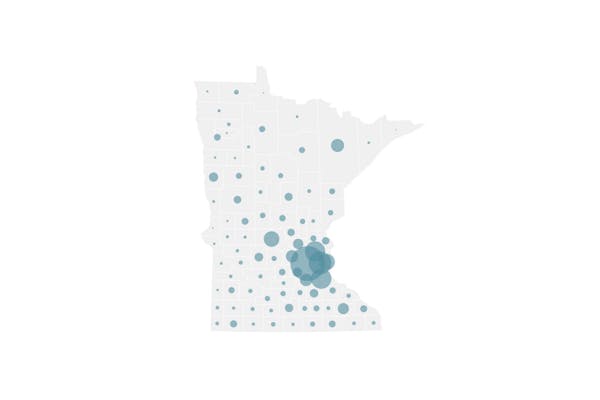So, what's your titer?
That question, still strange sounding, may soon become important as vaccines bring about the endgame for COVID-19.
A person's COVID titer (pronounced TIGHT-er) is a measure of the concentration of virus-neutralizing antibodies in their blood. A high-enough titer of the antiviral proteins provides immunity to COVID-19, though researchers are still working to nail down exactly when protection ends.
Taking a vaccine is one way to build up a protective titer, and recovering from COVID-19 is another. Some patients are getting infusions of lab-grown or donated antibodies to increase their titers.
"Based on our knowledge of other viruses, the higher the titer, the more likely you are to have immunity," said Marc Jenkins, director of the Center for Immunology at the University of Minnesota. "But where the cutoff is [for loss of immunity] is still uncertain."
Now a $300 blood test made by Imanis Life Sciences in Rochester is offering consumers a quantitative measurement of their neutralizing antibody titers. Multiple such tests could track the decline of antibodies over time.
Unlike most other antibody tests authorized in the United States, Imanis' Immuno-Cov V2.0 test returns a number that represents the concentration of virus-killing antibodies in the sample, instead of just a "yes" or "no" on whether antibodies were detected.
Just as important, the test counts only neutralizing antibodies, which disable the virus. Only a small proportion of the tiny proteins actually block the virus' spread, but most antibody tests on the market today don't discern between neutralizing and non-neutralizing antibodies.
"It's the neutralizing antibodies that matter," said Dr. Stephen Russell, CEO of Imanis and a viral-therapy researcher at Mayo Clinic. "Whatever antibody test you get, what you really want to know is, do I have neutralizing antibodies and how much do I have?"
Antibody titers decline at variable rates in different people. Internal data from Imanis shows that two of 14 people who got their titers measured twice had no detectable neutralizing antibodies after six months, and two more had titers that hovered just above the test's limit of detection.
Such insights could inform decisions about whether someone needs a COVID-19 vaccine booster shot, especially if they work in a field such as health care, Russell said.
An earlier version of the neutralizing antibody test became available through Mayo Clinic in June.
Version 2.0, which became available to the public via physician order online late last month, is run directly by Imanis. It's a refined and revalidated version of the original, and Imanis made enough testing medium to run 5 million of the second-generation tests at its own lab.
Antibody testing cannot diagnose an active case of COVID-19; that can be done only by polymerase chain reaction (PCR) technology. In Minnesota, another form of testing that looks for viral molecules called "antigens" can provide a probable diagnosis.
The latest numbers
On Sunday, the Minnesota Department of Health reported 5,581 new confirmed or probable cases of COVID-19, bringing the state's cumulative total above 350,000 for the first time.
Fewer than 9% of the 67,435 PCR and antigen test results announced Sunday were positive. Minnesota's case-positivity rate has seesawed in recent weeks, with seven-day averages fluctuating between 9% and 15%. Before November, daily positivity rates hadn't cracked double digits since mid-May.
Public-health officials also announced 64 new deaths from COVID on Sunday, bringing the statewide toll to 3,984. All but two who died were 55 or older, and more than half of them lived in assisted-living or long-term care.
On Thursday, a committee of medical experts convened by the U.S. Food and Drug Administration will publicly debate the evidence supporting America's first COVID vaccine, made by U.S.-based Pfizer and the German biotech firm BioNTech.
The data will show the vaccine was effective in 95% of people in clinical testing, the companies say. But the U's Marc Jenkins said future analysis of titers in the people who got COVID despite being vaccinated may go a long way toward defining the protective level of neutralizing antibodies.
"If all these people had titers of less than 200, say, then you could start to think about a cutoff," he said. Neutralizing antibody testing is "going to become more and more valuable as we understand the immunity better."
Measuring neutralizing antibodies is how the FDA and vaccine makers are testing immune responses — that has been one of the main uses thus far. The FDA authorized its first commercial neutralizing antibody test, made by GenScript USA, last month.
"Patients should not interpret results as telling them they are immune, or have any level of immunity, from the virus," FDA diagnostics director Dr. Tim Stenzel said at the time.
How the test works
Researchers say neutralizing antibodies are important mainly because of where they bind to the virus. Think of the coronavirus picture you have seen many times: a sphere with spikes protruding all over its surface. Those spikes are critical to how the virus attacks a host cell and reproduces. Neutralizing antibodies attach to the spike and gum up the virus' molecular machinery, blocking viral spread.
The Imanis test is designed to emit light inside a laboratory machine when a sample that contains neutralizing antibodies is exposed to an innocuous virus that has been genetically engineered to have coronavirus spikes. Non-neutralizing antibodies don't trigger the glow.
Imanis senior scientist Rianna Vandergaast said it's likely that no single magic titer applies to everyone. But eventually people will be able to see where they fall within broad categories such as low, moderate or high titers. And they'll be able to track change over time.
"That's where I think there is going to be demand for this kind of test long-term, to enable people to ... make sure that the protection they got from that infection or that vaccine is still there," Vandergaast said.
Joe Carlson • 612-673-4779
Oakdale issues warning after coyote attacks dog in nature preserve

Anoka County extends search for county administrator

Minneapolis schools, teachers reach tentative agreement to avert strike

